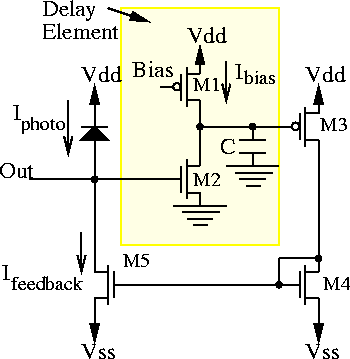Although Chong et al.'s chip ( [Chong et al. 92]) detects intensity
changes over time, it does not attempt to implement any algorithm of
vision, and the only operation performed on the chip is analog
temporal differentiation of photocurrents. The chip, however,
utilizes a compact current mode circuit for differentiating the
photocurrents and generating a pulse on the occurrence of an
increasing or decreasing light intensity. The current mode
differentiator is shown in Figure 3.19. When the
input light intensity decreases, the voltage at the node Out
goes down. The negative feedback loop will eventually fix the
operating point of the circuit at a point where
![]() . In the mean time a voltage pulse will be
detected at the output. This voltage pulse is converted to current and
read out through a x-y switch network.
. In the mean time a voltage pulse will be
detected at the output. This voltage pulse is converted to current and
read out through a x-y switch network.
There are two issues that the circuit faces with. Firstly, the circuit
can only detect decreases in the intensity. This is because of using
the simple inverting amplifier consisting of M1 and M2, instead of a
conventional OTA. This can be resolved by using a 5-transistor OTA. An
increase in the input of the delay element increases the current drive
of M2 which can quickly charge up the capacitor. The second problem is
that the circuit is conditionally stable. It can easily be shown that
in order to stabilize the circuit, the biasing current, ![]() ,
should be very small.
,
should be very small.
The implemented chip contains 25 ![]() 25 cells. In the 3
25 cells. In the 3 ![]() m CMOS
process a cell area of 22000
m CMOS
process a cell area of 22000 ![]() is achieved.
is achieved.

Figure 3.19: Chong's current mode differentiator.